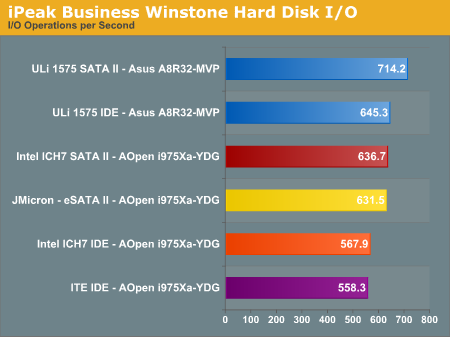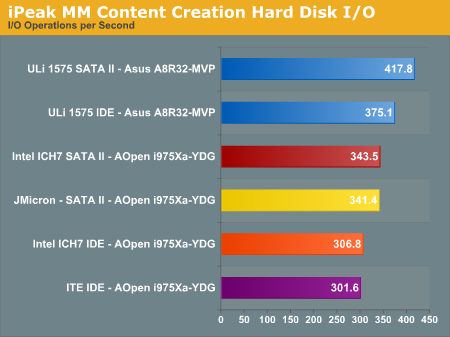Intel Core Duo: AOpen i975Xa-YDG to the Rescue
by Gary Key on May 4, 2006 8:00 AM EST- Posted in
- Motherboards
Disk Controller Performance
The AnandTech iPeak test is designed to measure "pure" hard disk performance, and in this case, we kept the hard drive as consistent as possible while varying the hard drive controller. The idea is to measure the performance of a hard drive controller with a consistent hard drive.We played back our raw files that are recorded I/O operations when running a real world benchmark - the entire Winstone 2004 suite. Intel's iPEAK utility was then used to play back the trace file of all I/O operations that took place during a single run of Business Winstone 2004 and MCC Winstone 2004. To try to isolate performance differences to the controllers that we were testing, we used the Maxtor MaXLine III 7L300S0 300GB 7200 RPM SATA drive in all tests. The drive was formatted before each test run and a composite average of 5 tests on each controller interface was tabulated in order to ensure consistency in the benchmark.
iPeak gives a mean service time in milliseconds; in other words, the average time that each drive took to fulfill each I/O operation. In order to make the data more understandable, we report the scores as an average number of I/O operations per second so that higher scores translate into better performance. This number is meaningless as far as hard disk performance is concerned, as it is just the number of I/O operations completed in a second. However, the scores are useful for comparing "pure" performance of the storage controllers in this case.


The performance patterns hold steady across both Multimedia Content I/O and Business I/O, with the ULi based SATA controller providing the a 12% improvement in I/O operations over the Intel and JMicron SATA controllers. The ULi IDE controller logic continues to be one of the best IDE solutions, posting scores that are higher than the Intel SATA controller and over 13% better than the Intel and ITE IDE controller.










81 Comments
View All Comments
Gary Key - Friday, May 5, 2006 - link
Sorry, being a selfish s.o.b. with this drive, actually I am testing two of them for an upcoming article. :)
sabrewulf - Thursday, May 4, 2006 - link
I haven't been following the development of Conroe too closely, but isn't this chip essentially performing like Conroe will? Or am I missing something?Some of the tests were impressive, but the gaming tests were certainly not "20-40%" improvement over AMD like everyone is wishing.
MrKaz - Thursday, May 4, 2006 - link
And "will" never be.Don’t forget Intel was using:
- Some special ATI driver.
- Crossfire setup (maybe modified),
20%~40% that you will never get, unless you have such kind of configuration.
On non SLI/Crossfire configuration will never be higher than 5%, 10% improvement...
And thanks that a lot to the 4MB cache, and minor processor (P3 redesign) changes.
Don’t forget that the Intel dual core with 4MB shared cache can act as one BIG single core processor with 4MB cache and the second core with 0MB of cache for the extra “stupid” calc...
IntelUser2000 - Thursday, May 4, 2006 - link
LOL. I always doubt that people can be such a dumb fanboy even I see them over and over again in time.
How do you explain Xtremsystems benchmark, and all the architectural advantages?? Did Netburst's poor showing really blind you??
MrKaz - Friday, May 5, 2006 - link
Fun boy me?It's you who calls him self by the stupid nick name Inteluser2000.
Some time there are complete morons here and you are one of them.
ME the "fan boy" has to "defend" Intel, a thing that you with your little brain can’t do.
Read my reply to your fan boy friends, there you will find why conroe will be good, and it's not because it's Intel.... dumb moron....
redbone75 - Thursday, May 4, 2006 - link
I don't think it was a "special" driver per se, if I recall the driver had some changes made in order to recognize Conroe.
I just love how a lot of people refer to Conroe as a P3 redesign as if it's something so bad. No, it's not a P3 redesign, there are elements of what made the P3 so successful incorporated into the chip, but that's not what makes the chip so awesome. Also, so what if it is ultimately just a "P3 redesign" as you put it? You use what works, and obviously this works. Hey, the K7 core was pretty good, and K8 is so well designed that AMD can ride it for a few more years.
MrKaz - Friday, May 5, 2006 - link
"in order to recognize Conroe"Why they need to recognize Conroe?
-Would work?
-Did work but with inferior performance?
-Special optimizations?
-New instruction set (SSE4) support for improved performance?
Questar - Thursday, May 4, 2006 - link
Wow, some fanboys are still in denial.This is an interim MOBILE chip that just put the smack down on an Opteron. What's going to happen when the real thing comes out?
MrKaz - Friday, May 5, 2006 - link
When the real thing come out? That’s easy:Core duo plus:
- 2MB cache (+5%~10%)
- 2X FSB (+4%~8%)
- 800Mhz DDR2 (3%~6%)
- x64 support (0%)
- Higher clock speed 2.1Ghz to 3.3Ghz (anyone can say 50% performance increase?)
I’m not a fan boy, it’s you Intel stupid morons that can even read and make some thought why should Conroe be faster than AMD Athlon 64….
Go back and reread the article about:
Intel Core versus AMD's K8 architecture
Don’t expect conroe be very different from core duo... I’m not saying that’s bad…
Questar - Friday, May 5, 2006 - link
You forgot a couple of things:Addidtional ALU Unit
Twice the SSE performace
Better code reordering
Larger reservation station
New micro-ops